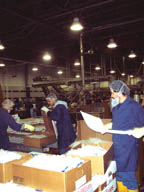
Equally surprising is the choice for DuPont's Diamond Award, which goes to the container the judging panel deems to be most innovative. Given the honor is sponsored by DuPont Packaging & Industrial Polymers, creativity in the use of plastic resins is almost a given. True, there is a thin, coextruded polymer layer on the peelable foil ends of containers from this year's winner, Crown Food Europe, but 99 percent of the materials are-gasp!-metal, the replacement container of choice for flexible and rigid plastic packaging.
A subsidiary of Philadelphia-based Crown Holdings Inc., Crown Food Europe created the container at its Wantage, England, R&D center, where Director Terry Benge has headed work on easy-open lids for sanitary cans since 1996 (see "Zero-defect engineering," Food Engineering, October 2004). The peelable can end is an extension of Crown's easy-open work. Several hundred thousand ends were produced in Wantage's pilot plant for France's William Saurin company's launch of a ready-to-eat line of meat salads called Salades Gourmandes in single-serve bowls, according to Daniel Abramowicz, Crown's executive vice president of corporate technologies.
"All sanitary metal packaging has some polymer coatings, and this is one of the new applications," says Abramowicz. With the peelable ends, a conductive or inductive heat seal is created between the polypropylene on the lid's edge and the lip of the can. Other than a heat-seal unit, food packagers do not need any additional equipment to use the bowl can. Abramowicz says, "There is a typical flange on the outside of the ring, so customers can seam it just like any other can." Alcan supplies the foil lid, and Corus is the metal plate supplier.
Crown's new bowl is targeted toward upscale products because good margins enable marketers to justify the unit's cost, Abramowicz says. "This bowl is too deep for a microwavable product. The polymer reduces sparking, but you wouldn't get enough energy into the bowl." However, modifications to the bowl design could make peelable ends a natural for microwave applications.
Other DuPont Gold Award winners include: EDV Packaging Solutions of Spain, which created a plastic microwavable baby-food package for Nestlé France SAS; Hangzhou Zhengda Printing & Packaging Co. Ltd., a Chinese firm that created a process for incorporating a straw inside a PET pouch during the forming process; and O'Keefe's Company Inc., based in Sisters, OR, which designed an easy-grip polypropylene jar for a skin therapy cream it sells to surgeons, construction workers and others who work with their hands.
For more information:
Daniel Abramowicz, Crown Holdings Inc.,
215-698-5143,
daniel.abramowicz@crowncork.com
Build a greener box: Paper container suppliers are closing in on an answer to supermarkets' demands for recyclable boxes.
Grocers hate waxed boxes. Waxed boxes are a staple for shipping vegetables on ice from farm fields to supermarkets. As much as half of the fresh poultry moving through the supply chain also is packed with ice in waxed containers. Unfortunately, those boxes represent a disposal cost for grocers, and major supermarkets are beginning to mandate recyclable alternatives.
An added complication is that the bio-friendly replacement has to come from a third party: container suppliers. It's an unusual dynamic that pushes paperboard suppliers to deliver the elusive win-win: a recyclable box that saves both shippers (the buyers) and retailers (the users) money, rather than simply adding cost for food suppliers. Paper companies pay grocers for the recyclable cartons they return. If a disposal cost is to be converted to a revenue stream, box suppliers reason, shouldn't the savings help defray the added cost of the solution? One paper manufacturer set a 20-cent ceiling on the added cost of wax alternatives; now the firm is trying to ensure its customers don't bear the entire surcharge.
"For the longest time, we didn't listen to our customers' customers," confides Charlie Pierce, sales director for Lake Forest, IL-based Packaging Corporation of America. Understanding the need for waxless containers strong enough to be stacked and actually delivering them are two different things, however, and the mid-sized container supplier continues to seek a solution.
Smurfit-Stone Container Corp. thought it had the answer with VPS, a produce box lined with micro-perforated film. Eric Lemanski, innovation technical representative, says the perforation pattern changes, depending on the product being transported. A liner for broccoli was the first film produced. Although VPS was introduced to the trade last fall, Smurfit-Stone says it is not ready for commercial application.
A different approach is being taken by International Paper and Weyerhaeuser Co. Both have developed biodegradable chemical coatings to replace wax. Weyerhaeuser offers four classes of containerboard in its "clima series" to address different moisture-resistance and strength requirements, according to Melissa Johnson, new products manager, Federal Way, WA. The containers meet new testing protocols that determine whether materials have a predictable impact in mill repulping systems and meet performance standards for users of the recycled paper. The protocol was developed under the auspices of the Corrugated Packaging Alliance.
Wax-impregnated, wax curtain-coated and wax-cascaded boxes exist for different food types. The replacement line boasts four grades, beginning with ClimaGuard for low-humidity environments and extending to a box that is enclosed in plastic film and can be fully submerged in water.
Field tests involving a North Carolina peach-grower suggest the new coatings can extend the shelf life of some products, Johnson says. That benefit should help encourage market innovators to adopt the replacement containers, which eventually are expected to become the food-shipping standard.
For more information:
Charles Pierce, Packaging Corporation of America,
781-934-7194,
cpierce@packagingcorp.com
Eric Lemanski, Smurfit-Stone Container Corp.,
630-260-6675,
elemanski@smurfit.com
Melissa Johnson, Weyerhaeuser,
253-924-6273,
melissa.johnson@weyerhaeuser.com

